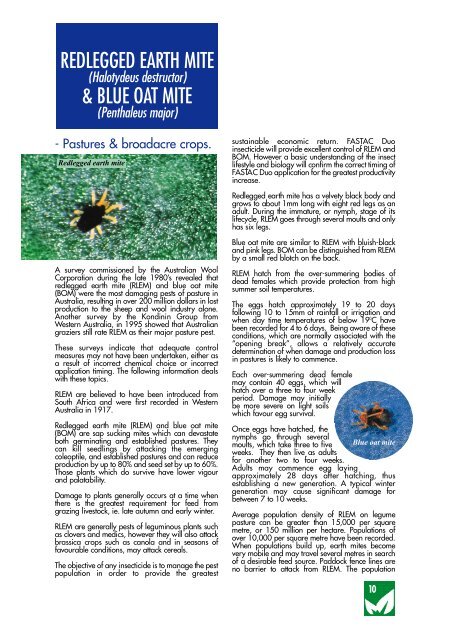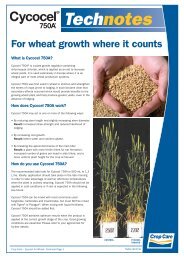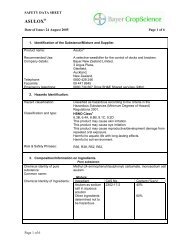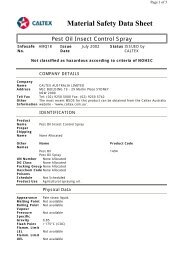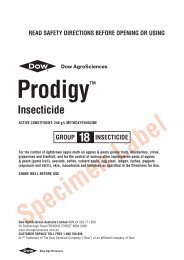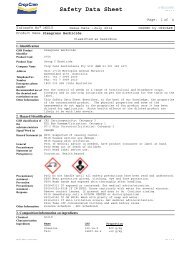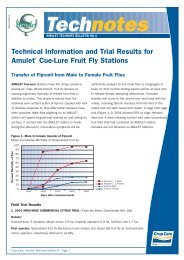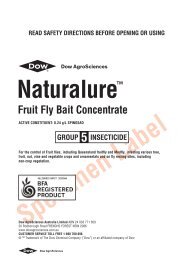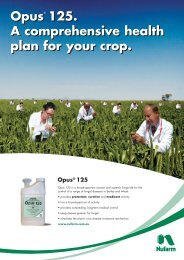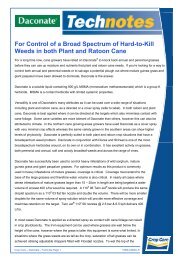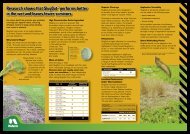Fastac Duo Technical Manual - Pest Genie
Fastac Duo Technical Manual - Pest Genie
Fastac Duo Technical Manual - Pest Genie
Create successful ePaper yourself
Turn your PDF publications into a flip-book with our unique Google optimized e-Paper software.
REDLEGGED EARTH MITE<br />
(Halotydeus destructor)<br />
& BLUE OAT MITE<br />
(Penthaleus major)<br />
- Pastures & broadacre crops.<br />
Redlegged earth mite<br />
sustainable economic return. FA S TAC <strong>Duo</strong><br />
insecticide will provide excellent control of RLEM and<br />
BOM. However a basic understanding of the insect<br />
lifestyle and biology will confirm the correct timing of<br />
FA S TAC <strong>Duo</strong> application for the greatest productivity<br />
i n c r e a s e .<br />
Redlegged earth mite has a velvety black body and<br />
grows to about 1mm long with eight red legs as an<br />
adult. During the immature, or nymph, stage of its<br />
lifecycle, RLEM goes through several moults and only<br />
has six legs.<br />
A survey commissioned by the Australian Wo o l<br />
Corporation during the late 1980’s revealed that<br />
redlegged earth mite (RLEM) and blue oat mite<br />
(BOM) were the most damaging pests of pasture in<br />
Australia, resulting in over 200 million dollars in lost<br />
production to the sheep and wool industry alone.<br />
Another survey by the Kondinin Group from<br />
We s t e rn Australia, in 1995 showed that Australian<br />
graziers still rate RLEM as their major pasture pest.<br />
These surveys indicate that adequate control<br />
measures may not have been undertaken, either as<br />
a result of incorrect chemical choice or incorrect<br />
application timing. The following information deals<br />
with these topics.<br />
RLEM are believed to have been introduced from<br />
South Africa and were first recorded in We s t e rn<br />
Australia in 1917.<br />
Redlegged earth mite (RLEM) and blue oat mite<br />
(BOM) are sap sucking mites which can devastate<br />
both germinating and established pastures. They<br />
can kill seedlings by attacking the emerging<br />
coleoptile, and established pastures and can reduce<br />
production by up to 80% and seed set by up to 60%.<br />
Those plants which do survive have lower vigour<br />
and palatability.<br />
Damage to plants generally occurs at a time when<br />
there is the greatest requirement for feed from<br />
grazing livestock, ie. late autumn and early winter.<br />
RLEM are generally pests of leguminous plants such<br />
as clovers and medics, however they will also attack<br />
brassica crops such as canola and in seasons of<br />
favourable conditions, may attack cereals.<br />
The objective of any insecticide is to manage the pest<br />
population in order to provide the greatest<br />
Blue oat mite are similar to RLEM with bluish-black<br />
and pink legs. BOM can be distinguished from RLEM<br />
by a small red blotch on the back.<br />
RLEM hatch from the over-summering bodies of<br />
dead females which provide protection from high<br />
summer soil temperatures.<br />
The eggs hatch approximately 19 to 20 days<br />
following 10 to 15mm of rainfall or irrigation and<br />
when day time temperatures of below 19 0 C have<br />
been recorded for 4 to 6 days. Being aware of these<br />
conditions, which are normally associated with the<br />
“opening break”, allows a relatively accurate<br />
d e t e rmination of when damage and production loss<br />
in pastures is likely to commence.<br />
Each over-summering dead female<br />
may contain 40 eggs, which will<br />
hatch over a three to four week<br />
period. Damage may initially<br />
be more severe on light soils<br />
which favour egg surv i v a l .<br />
Once eggs have hatched, the<br />
nymphs go through several<br />
moults, which take three to five Blue oat mite<br />
weeks. They then live as adults<br />
for another two to four weeks.<br />
Adults may commence egg laying<br />
approximately 28 days after hatching, thus<br />
establishing a new generation. A typical winter<br />
generation may cause significant damage for<br />
between 7 to 10 weeks.<br />
Average population density of RLEM on legume<br />
pasture can be greater than 15,000 per square<br />
metre, or 150 million per hectare. Populations of<br />
over 10,000 per square metre have been recorded.<br />
When populations build up, earth mites become<br />
v e ry mobile and may travel several metres in search<br />
of a desirable feed source. Paddock fence lines are<br />
no barrier to attack from RLEM. The population<br />
1 0


